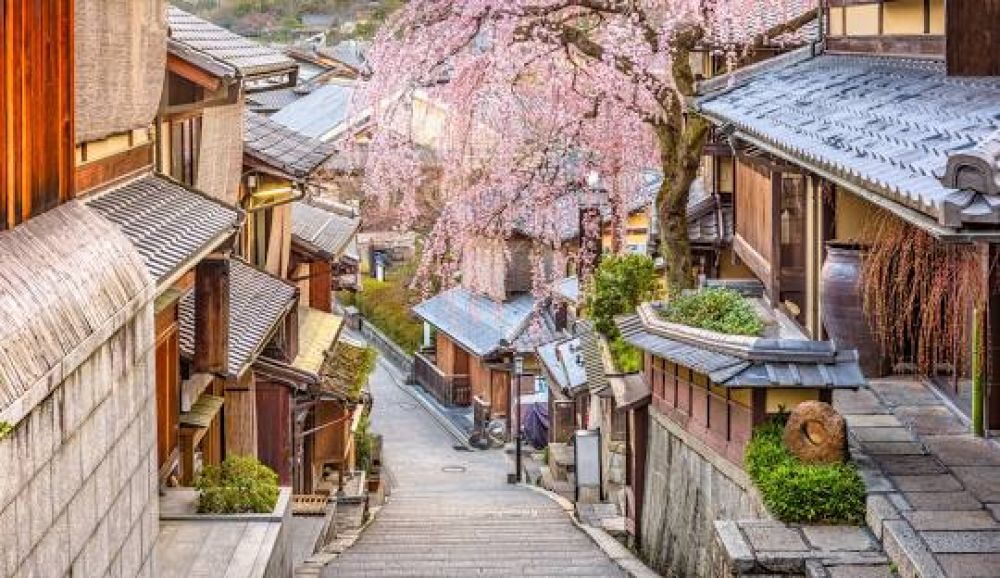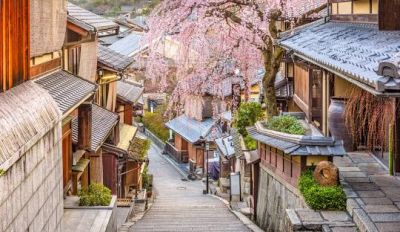

Fushimi Inari Taisha is an indispensable part of a Kyoto sightseeing itinerary. Known for its iconic rows of vermilion torii gates, which straddle a network of trails behind the main shrine, the site offers a picturesque and somewhat spiritual experience. The trails take you into the wooded forest of the sacred Mount Inari, which stands at 233 meters and belongs to the shrine grounds. This Shinto shrine is dedicated to Inari, the deity of rice, sake, and prosperity. As you walk up the mountain, you'll pass numerous smaller shrines with stacks of mini torii gates given by visitors for good luck. It is also common to see statues of foxes, which are thought to be the messengers of Inari. A complete walk along the whole trail network is around 2-3 hours, but visitors can turn back at any point.
The Kyoto Imperial Palace, once the seat of Japan's Imperial Family until the capital moved to Tokyo in 1869, is a must-see for those interested in Japanese history and architecture. Located in the expansive Kyoto Imperial Park, the palace is known for its elegant Japanese aesthetics, beautiful gardens, and historical significance. The palace is made up of numerous buildings, including the Emperor's residence, halls for state ceremonies, and the Imperial Library. A tour of the palace provides a rich insight into the lifestyles of Japan’s ancient Imperial royalty and typically includes the various throne rooms, banquet halls, and private chambers. A guided tour ensures that visitors understand the context and significance of what they're seeing, as explanations are offered on the functions of different buildings and the symbolism embedded in the palace design.
Arashiyama Bamboo Grove is one of Kyoto's top sights and for good reason: standing amid these soaring stalks of bamboo is like being in another world. The grove is particularly beautiful when there is a light wind and the tall bamboo stalks sway gently back and forth across the sky. The creaking sounds and the light filtering through the dense forest make for a serene and almost otherworldly experience. It is a great location for photography or simply a peaceful stroll. The grove is part of the larger Arashiyama district, an area that also features temples and shrines, the picturesque Togetsukyo Bridge, and a variety of restaurants and shops. It’s a perfect activity to combine with sightseeing in the wider area. Arashiyama can be crowded, so an early morning visit is recommended for the best experience.
Kinkaku-ji, also known as the Golden Pavilion, is one of Kyoto's most famous temples and a World Heritage Site. The pavilion is a stunning three-story building on the grounds of a larger complex, set amongst beautiful traditional Japanese gardens. The top two floors are completely covered in gold leaf, and it sits alongside a tranquil pond that reflects the pavilion. Originally a retirement villa for the shogun Ashikaga Yoshimitsu, it was converted into a Zen temple after his death in accordance with his will. The garden and buildings, centered around the Golden Pavilion, were said to represent the Pure Land of Buddha in this world. The temple can be quite crowded, but visitors always manage to find a moment of peace while gazing at the majestic structure and its reflection on the water. The visit usually includes a walk through the gardens, which offer different views of the pavilion and seasonal floral displays.
Gion is Kyoto's famed geisha district, filled with shops, restaurants, and ochaya (tea houses) where geiko (Kyoto dialect for geisha) and maiko (geiko apprentices) entertain. Exploring Gion offers a glimpse into traditional Japanese entertainment and culture. The area's streets and architecture have been carefully preserved, offering a historic ambiance. You might even encounter a maiko in her elaborate dress and makeup. A Gion walking tour would typically explore significant landmarks, like Hanami-koji Street, the Shirakawa area with its picturesque canals, and perhaps Pontocho Alley, known for its traditional dining establishments. Experienced guides often share stories about the district's history and the life of a geisha. Many tours happen in the evening, providing the chance to see Gion's historic buildings lit up, amplifying the area's enchanting atmosphere.
Participating in a traditional Japanese tea ceremony is a memorable and uniquely Kyoto experience. The tea ceremony is a choreographic ritual of preparing and serving Japanese green tea, called matcha, together with traditional Japanese sweets to balance with the bitter taste of the tea. The practice is deeply rooted in Zen Buddhism and is about much more than just drinking tea; it is a spiritual and philosophical experience that embodies harmony, respect, purity, and tranquility. During the ceremony, a tea master will demonstrate the art of tea-making and explain the cultural significance behind the ceremony’s precise movements and steps. Participants often get to try their hand at making their own tea as well. It's also an opportunity to wear a traditional kimono and immerse yourself in Japanese culture.
Nijo Castle, another of Kyoto's World Heritage Sites, offers a glimpse into the power and opulence of the Tokugawa shogunate during the Edo period. The castle's main attraction is Ninomaru Palace, renowned for its lavish interiors, intricate wood carvings, and expansive, beautifully-preserved frescoed rooms. Additionally, the castle features 'nightingale' floors designed to chirp when walked over as a security measure against intruders. The castle complex also boasts the Honmaru Palace (secondary circle of defense) and several beautiful gardens. The gardens include cherry and plum tree orchards, serene ponds, and carefully placed stones and topiary. Exploring the castle's compounds gives a comprehensive view of traditional Japanese feudal architecture and landscaping practices. Nijo Castle is enjoyable to visit in every season, with cherry blossoms in the spring and colorful foliage in the fall.
The Philosopher's Path is a charming stone path through the northern part of Kyoto's Higashiyama district. The approximately two-kilometer-long path follows a canal lined with hundreds of cherry trees. Named after the influential 20th-century Japanese philosopher Nishida Kitaro who was said to meditate while walking this route daily on his way to Kyoto University, the Philosopher's Path is especially popular during the spring cherry blossom season when the trees are in full bloom. The path starts near the Silver Pavilion (Ginkaku-ji) and ends in the neighborhood of Nanzen-ji temple, with many small temples and shrabsaen to explore along the way. Cafes, boutiques, and craft shops also line the route, offering pleasant diversions. While the walk can be completed rather quickly, visitors often take their time to absorb the scenery and the tranquil, contemplative atmosphere.
A kimono-wearing experience allows visitors to immerse themselves into traditional Japanese culture. In Kyoto, the heart of Japan's cultural heritage, numerous shops offer the chance to be dressed in a kimono by professionals. Guests can choose from a variety of patterns and colors to suit individual tastes. After being dressed, many choose to take a stroll through historic districts such as Gion, Higashiyama or around Kiyomizu-dera temple to take memorable photographs in traditional Japanese surroundings. The service typically includes dressing, hair-styling compatible with the kimono, and sometimes even a photoshoot or a brief cultural introduction to the kimono's significance. It's an unforgettable way to engage with Japanese customs and makes for fantastic photo opportunities to remember your Kyoto visit.
Exploring Kyoto by bike is an excellent way to enjoy the city’s beautiful scenery and historic sites. Many parts of Kyoto are best accessed by narrow lanes and paths that are difficult to reach by bus or car. Bike tours typically take visitors through various attractions, offering a mix of sightseeing, exercise, and an eco-friendly mode of transport. Cyclists might explore paths along the Kamo River, visit iconic sites like the Heian Shrine, Kiyomizu Temple, or even the bamboo forests of Arashiyama. Biking allows for a closer connection with the city and more intimate access to lesser-known spots. Many tours offer different routes to cater to different fitness levels and interests, ensuring a personalized experience. Guides often share insights into the local culture and history, making for an educational and engaging way to tour Kyoto.
